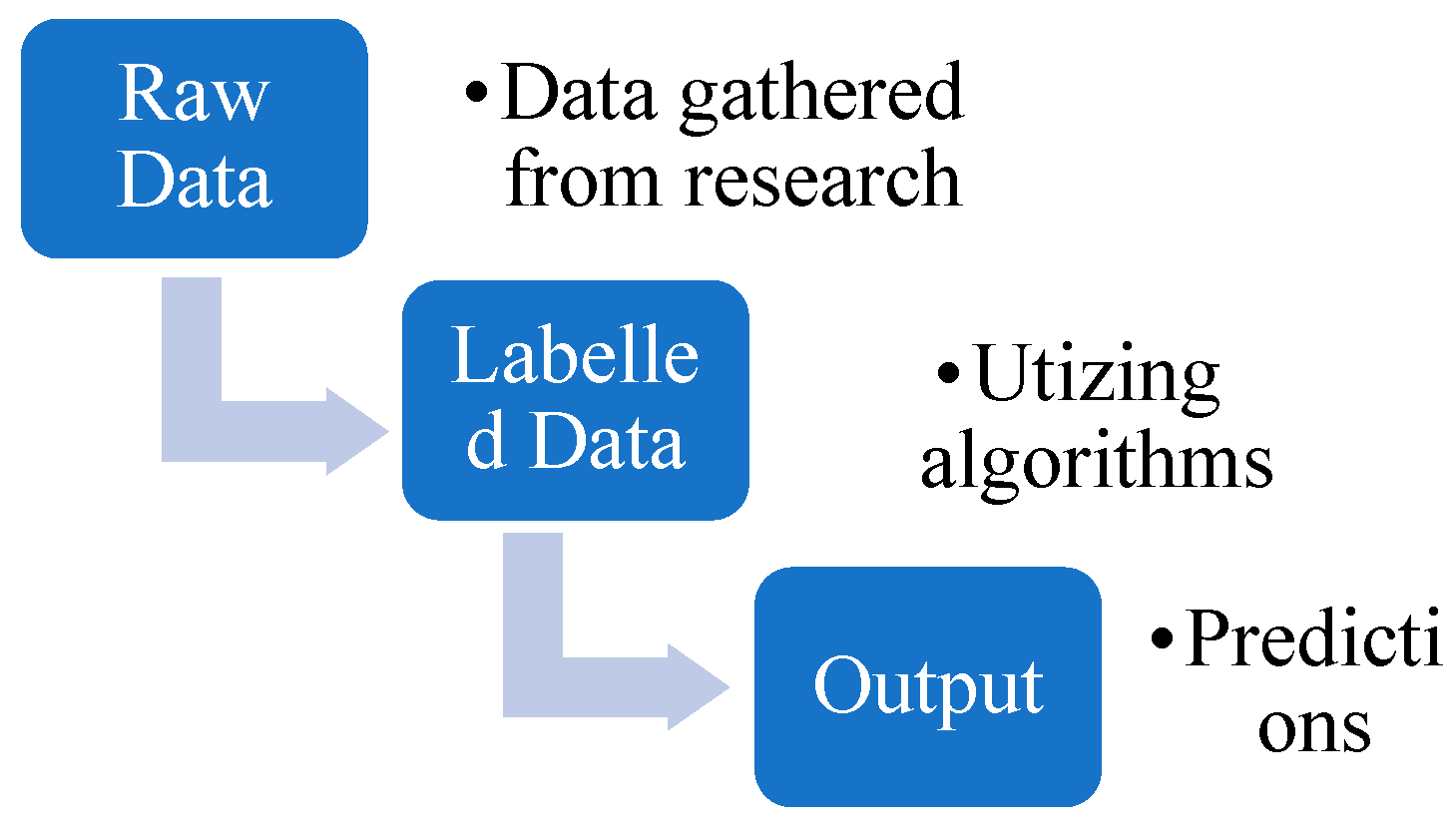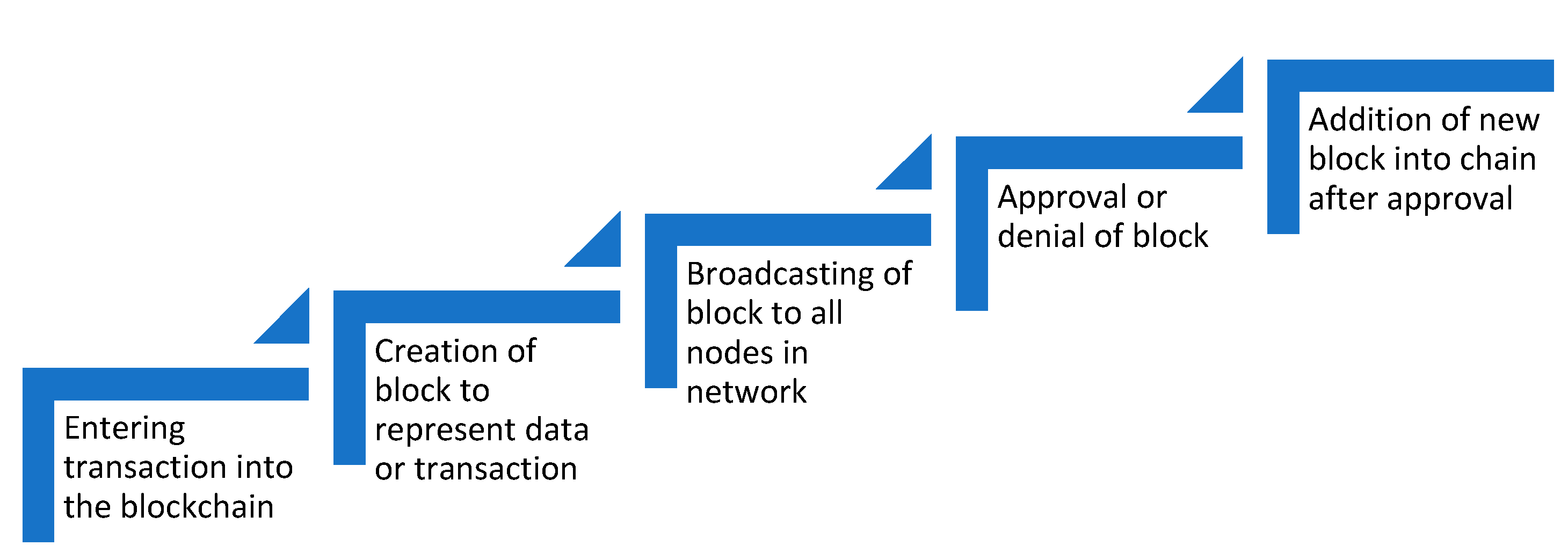Investigating Cervical Cancer Detection Frameworks Based on Machine Learning: The Critical Tradeoff Between Accuracy and Data Security †
Abstract
1. Introduction
2. Objectives of the Study
- Reviewing the previously proposed framework for the detection of cervical cancer in terms of accuracy as well as data security while communicating across healthcare institutions;
- Comparing the reviewed framework with the help of techniques, algorithms, tools, a utilized dataset, and data types, and in terms of benefits, limitations, accuracy, and data security.
- Analyzing the results and research gaps that must be considered to provide foolproof frameworks for the early, secure, and accurate diagnosis of cervical cancer.
3. Literature Review
4. Comparison Table
5. Discussion and Gap Analysis
6. Conclusions and Future Scope
Author Contributions
Funding
Institutional Review Board Statement
Informed Consent Statement
Data Availability Statement
Conflicts of Interest
References
- Eun, T.J.; Perkins, R.B. Screening for cervical cancer. Med. Clin. N. Am. 2020, 104, 1063–1078. [Google Scholar] [CrossRef]
- Burmeister, C.A.; Khan, S.F.; Schäfer, G.; Mbatani, N.; Adams, T.; Moodley, J.; Prince, S. Cervical cancer therapies: Current challenges and future perspectives. Tumour Virus Res. 2022, 13, 200238. [Google Scholar] [CrossRef]
- Al Mudawi, N.; Alazeb, A. A model for predicting cervical cancer using machine learning algorithms. Sensors 2022, 22, 4132. [Google Scholar] [CrossRef]
- Habehh, H.; Gohel, S. Machine learning in Healthcare. Curr. Genom. 2021, 22, 291–300. [Google Scholar] [CrossRef] [PubMed]
- Jiang, T.; Gradus, J.L.; Rosellini, A.J. Supervised machine learning: A brief primer. Behav. Ther. 2020, 51, 675–687. [Google Scholar] [CrossRef] [PubMed]
- Lu, J.; Xie, X.; Xiong, Y. Multi-view hypergraph regularized LP norm least squares twin support vector machines for semi-supervised learning. Pattern Recognit. 2024, 156, 110753. [Google Scholar] [CrossRef]
- Vaigandla, K.K.; Karne, R.; Siluveru, M.; Kesoju, M. Review on Blockchain technology: Architecture, characteristics, benefits, algorithms, challenges and applications. Mesopotamian J. Cybersecur. 2023, 2023, 73–85. [Google Scholar] [CrossRef]
- Nasir, M.U.; Khalil, O.K.; Ateeq, K.; Almogadwy, B.S.; Khan, M.A.; Adnan, K.M. Cervical cancer prediction empowered with Federated Machine Learning. Comput. Mater. Contin. 2024, 79, 963–981. [Google Scholar] [CrossRef]
- Uddin, K.M.; Al Mamun, A.; Chakrabarti, A.; Mostafiz, R.; Dey, S.K. An ensemble machine learning-based approach to predict cervical cancer using hybrid feature selection. Neurosci. Inform. 2024, 4, 100169. [Google Scholar] [CrossRef]
- Nour, M.K.; Issaoui, I.; Edris, A.; Mahmud, A.; Assiri, M.; Ibrahim, S.S. Computer aided cervical cancer diagnosis using gazelle optimization algorithm with Deep Learning Model. IEEE Access 2024, 12, 13046–13054. [Google Scholar] [CrossRef]
- Mudhar, J.K.; Malhotra, J.; Rani, S. A smart contract based automated cervical cancer prediction using Ensemble Machine Learning. In Proceedings of the 2024 2nd International Conference on Advancement in Computation & Computer Technologies (InCACCT), Gharuan, India, 2–3 May 2024; pp. 298–302. [Google Scholar] [CrossRef]
- Arunachalam, P.; Janakiraman, N.; Rashid, J.; Kim, J.; Samanta, S.; Naseem, U.; Sivaraman, A.K.; Balasundaram, A. Effective classification of synovial sarcoma cancer using structure features and support vectors. Comput. Mater. Contin. 2022, 72, 2521–2543. [Google Scholar] [CrossRef]
- Shakil, R.; Islam, S.; Akter, B. A precise machine learning model: Detecting cervical cancer using feature selection and explainable AI. J. Pathol. Inform. 2024, 15, 100398. [Google Scholar] [CrossRef] [PubMed]
- Sharma, V.; Kumar, A.; Sharma, K. Digital Twin Application in women’s Health: Cervical cancer diagnosis with cervixnet. Cogn. Syst. Res. 2024, 87, 101264. [Google Scholar] [CrossRef]
- Al Qathrady, M.; Shaf, A.; Ali, T.; Farooq, U.; Rehman, A.; Alqhtani, S.M.; Alshehri, M.S.; Almakdi, S.; Irfan, M.; Rahman, S.; et al. A novel web framework for cervical cancer detection system: A machine learning breakthrough. IEEE Access 2024, 12, 41542–41556. [Google Scholar] [CrossRef]
- Aldhyani, T.H.H.; Khan, M.A.; Almaiah, M.A.; Alnazzawi, N.; Al Hwaitat, A.K.; Elhag, A.; Shehab, R.T.; Alshebami, A.S. A secure internet of medical things framework for breast cancer detection in sustainable smart cities. Electronics 2023, 12, 858. [Google Scholar] [CrossRef]
- Rehman, A.; Xing, H.; Feng, L.; Hussain, M.; Gulzar, N.; Khan, M.A.; Hussain, A.; Saeed, D. FedCSCD-Gan: A Secure and collaborative framework for clinical cancer diagnosis via optimized Federated Learning and gan. Biomed. Signal Process. Control 2024, 89, 105893. [Google Scholar] [CrossRef]
- Akmeşe, Ö.F. Data Privacy-aware machine learning approach in pancreatic cancer diagnosis. BMC Med. Inform. Decis. Mak. 2024, 24, 1. [Google Scholar] [CrossRef]
- AlSalman, H.; Al-Rakhami, M.S.; Alfakih, T.; Hassan, M.M. Federated Learning Approach for Breast Cancer Detection based on DCNN. IEEE Access 2024, 12, 40114–40138. [Google Scholar] [CrossRef]
- Lata, K.; Singh, P.; Saini, S.; Cenkeramaddi, L.R. Deep learning-based brain tumor detection in privacy-preserving smart health care systems. IEEE Access 2024, 12, 140722–140733. [Google Scholar] [CrossRef]
- Lee, S.; Abdullah, A.; Jhanjhi, N.Z. A review on honeypot-based botnet detection models for smart factory. Int. J. Adv. Comput. Sci. Appl. 2020, 11, 418–435. [Google Scholar] [CrossRef]
- Azeem, M.; Ullah, A.; Ashraf, H.; Jhanjhi, N.; Humayun, M.; Aljahdali, S.; Tabbakh, T.A. FoG-Oriented Secure and Lightweight Data Aggregation in IoMT. IEEE Access 2021, 9, 111072–111082. [Google Scholar] [CrossRef]
- Aldughayfiq, B.; Ashfaq, F.; Jhanjhi, N.Z.; Humayun, M. YOLO-Based Deep Learning Model for Pressure Ulcer Detection and Classification. Healthcare 2023, 11, 1222. [Google Scholar] [CrossRef] [PubMed]



| Techniques | Algorithm | Tool | Data Set | Data Type | Benefit | Limitation | Accuracy | Data Security | Ref. |
|---|---|---|---|---|---|---|---|---|---|
| Federated machine learning in the integration of Blockchain and Internet of Medical Things | Algorithms based on Scaled conjugate gradient, Levenberg Marquardt, and Bayesian regularization | MATLAB | UCI cervical cancer risk factors | Numeric | Study includes the security as well as privacy of healthcare sensitive data by getting feedbacks from the respective individuals | Proposed study required to be utilized at large scale. | 99.26% | Yes | [8] |
| Random oversampling and ensemble Machine Learning method i.e., hard voting | Algorithms based on machine learning classifiers | Jupyter Notebook and Google Colab | UCI Machine Learning repository | Numeric | Able to found best results with the combination of PCA, XGBoost, RF and MLP in the terms of accuracy and sensitivity | Unable to provide best results as an online screening tool along with security | 99.19% | No | [9] |
| CACCD-GOADL (Computer Aided Cervical Cancer Diagnosis utilizing Gazelle Optimizer Algorithm with deep learning) | SELM methodology along with MobileNetv3 system | Not defined | Herlev dataset | Images | Better results have found in terms of accuracy, precision, recall and F1-score as compared to other approaches. | No discussion regarding the security as well as privacy of the data | 99.38% | No | [10] |
| Machine learning and blockchain smart contracts | Automated prediction and secure algorithms | Graphical tool | Repositories | Numeric | Classification approaches are used to remove issues like over-fitting, outliers, bias present in the dataset and to provide more promising result. | Framework accuracy decreases with nearly by 6% after training of dataset | 93% | Yes | [11] |
| Support Vectors and structure feature selection | Linear Discriminant Analysis (LDA) and Support Vector Machine (SVM) | Not defined | Primary source dataset gathered from Kilpauk Medical College and Hospital, Government of Tamil Nadu | Images | Best classification results have found by utilizing machine learning approaches, Internet of Things and blockchain technology | Blockchain technology has not integrated with the deep learning algorithms for the secure communication over IoT network | 90.63% | Yes | [12] |
| Adaptive Synthetic Sampling and Synthetic Minority Oversampling | Support vector machine, k-nearest neighbor, random forest, naïve bayes, logistic regression, decision tree | Not defined | UCI machine learning repository | Numeric | Early detection of cervical cancer utilizing explainable Artificial Intelligence and feature selection | High computational cost, no data security and utilization of smaller datasets. | 97% | No | [13] |
| Digital Twin application | Cervix classifier model | Keras, Tensorflow, Sklearn package, python were utilized for the development along with Numpy and Pandas libraries. | Multi-cell dataset i.e., SIPaKMeD | Images | Reduction in the medical expenses, extension in the actual life expectancy, improvement in the health | No data security has considered by researchers in the respective proposal | 98.31% | No | [14] |
| Web framework for cervical cancer detection system | Machine learning algorithms | Pandas dataframe | UCI machine learning repository | Numeric with 36 attributes | Proposed framework is not just bound with providing results in diagnosis of cervical cancer | No data security has considered by researchers in the respective proposal | 98.1% | No | [15] |
| Internet of Medical Things, machine learning and blockchain | Gated recurrent units with neural networks | Not defined | Kaggle | Numeric | Detection of cancer is possible along with the data security by using blockchain systems and highly enhanced AES cryptosystems. | Standard datasets are utilized | 95% | Yes | [16] |
| Privacy preserving detection framework | Deep learning approaches | Python | kaggle | Images13] | Utilized enhanced integrated encryption algorithms for the secure detection of medical condition | Additional AI-assisted security frameworks must be involved. | 99.92% | Yes | [20] |
Disclaimer/Publisher’s Note: The statements, opinions and data contained in all publications are solely those of the individual author(s) and contributor(s) and not of MDPI and/or the editor(s). MDPI and/or the editor(s) disclaim responsibility for any injury to people or property resulting from any ideas, methods, instructions or products referred to in the content. |
© 2025 by the authors. Licensee MDPI, Basel, Switzerland. This article is an open access article distributed under the terms and conditions of the Creative Commons Attribution (CC BY) license (https://creativecommons.org/licenses/by/4.0/).
Share and Cite
Singla, S.; Sodhi, N.S.; Batra, I.; Somantri. Investigating Cervical Cancer Detection Frameworks Based on Machine Learning: The Critical Tradeoff Between Accuracy and Data Security. Eng. Proc. 2025, 107, 70. https://doi.org/10.3390/engproc2025107070
Singla S, Sodhi NS, Batra I, Somantri. Investigating Cervical Cancer Detection Frameworks Based on Machine Learning: The Critical Tradeoff Between Accuracy and Data Security. Engineering Proceedings. 2025; 107(1):70. https://doi.org/10.3390/engproc2025107070
Chicago/Turabian StyleSingla, Sofia, Navdeep Singh Sodhi, Isha Batra, and Somantri. 2025. "Investigating Cervical Cancer Detection Frameworks Based on Machine Learning: The Critical Tradeoff Between Accuracy and Data Security" Engineering Proceedings 107, no. 1: 70. https://doi.org/10.3390/engproc2025107070
APA StyleSingla, S., Sodhi, N. S., Batra, I., & Somantri. (2025). Investigating Cervical Cancer Detection Frameworks Based on Machine Learning: The Critical Tradeoff Between Accuracy and Data Security. Engineering Proceedings, 107(1), 70. https://doi.org/10.3390/engproc2025107070






